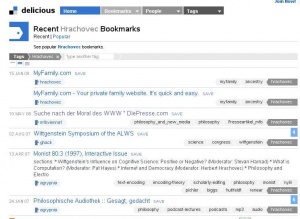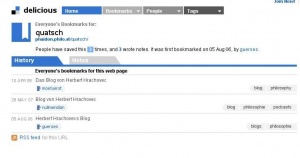Innovation (OSP): Unterschied zwischen den Versionen
Anna (Diskussion | Beiträge) (→zum Beispiel "Quatsch": Tabelle) |
Anna (Diskussion | Beiträge) K (→zum Beispiel "Quatsch": Bilder) |
||
| Zeile 64: | Zeile 64: | ||
{| class="wikitable" | {| class="wikitable" | ||
|- | |- | ||
| − | | [[Bild: | + | | [[Bild:zBqu1.jpg|thumb|300px]] || [[Bild:zBqu2.jpg|thumb|300px]] |
| + | |- | ||
| + | | [[Bild:zBqu3.jpg|thumb|300px]] || [[Bild:zBqu4.jpg|thumb|300px]] | ||
| + | |- | ||
| + | | [[Bild:zBqu5.jpg|thumb|300px]] || [[Bild:zBqu6.jpg|thumb|300px]] | ||
|} | |} | ||
Version vom 23. Januar 2009, 10:05 Uhr
Inhaltsverzeichnis
Yochai Benkler
aus: Commons-Based Peer Production and Virtue
II. COMMONS-BASED PEER PRODUCTION – PRINCIPLES
The phenomenon of large- and medium-scale collaborations among individuals, organized without markets or managerial hierarchies, is emerging everywhere in the information and cultural production system. Elsewhere, Benkler has provided a detailed analysis of the economics of this emerging phenomenon; here we briefly recapitulate this analysis, with a particular focus on characteristics that are relevant to the specific arguments of this paper.
At its core, peer production is a model of social production, emerging alongside contract- and market-based, managerial-firm based and state-based production. These forms of production are typified by two core characteristics. The first is decentralization. Authority to act resides with individual agents faced with opportunities for action, rather than in the hands of a central organizer, like the manager of a firm or a bureaucrat. The second is that they use social cues and motivations, rather than prices or commands, to motivate and coordinate the action of participating agents. As a descriptive matter, the phenomenon is a product of the emergence of digital networks and the rising importance of information and cultural production. The wide distribution of low-cost processors, coupled with increasingly ubiquitous computation, changes the capital structure of information production. Physical capital is widely distributed and owned by those individuals who also are capable of contributing the other major input into information and cultural production—human effort and creativity. Because it obviates the need for centralized capital investment, this capital structure makes possible — though does not require — the reorganization of at least some information and cultural production along decentralized lines. In this technical-economic context, peer-production enterprises appear to be emerging as newly feasible social and technical systems that motivate and organize human collective contributions by means other than contracts and monetary compensation for the use of physical capital.
Commons-based peer-production relations regularly exhibit three structural attributes. First, the potential objects of peer production must be modular. That is, they must be divisible into components, or modules, each of which can be produced independently of the production of the others. This enables production to be incremental and asynchronous, pooling the individual discrete efforts of different people, with different capabilities, who are available at different times. Second, the granularity of the modules is important. Granularity refers to the sizes of the project’s modules, and in order for a peer-production process successfully to pool a relatively large pool of contributors the modules should be predominantly fine-grained, or small in size. This allows the project to capture contributions from large numbers of contributors whose motivation level will not sustain anything more than quite small efforts towards the project. Novels, for example, at least those that look like our current conception of a novel, are likely to prove resistant to peer production. But as we have already suggested, encyclopedia entries, judgments about the worth of one or another website and components of software programs are commonly and effectively produced in this fashion. In addition, a project will likely be more efficient if it can accommodate variously sized contributions. Heterogeneous granularity will allow people with different levels of motivation to collaborate by contributing smaller or larger grained contributions, consistent with their level of motivation.
Finally, a successful peer-production enterprise must have low-cost integration—the mechanism by which the modules are integrated into a whole end product. Integration must include both quality controls over the modules and a mechanism for integrating the contributions into the finished product. First, the project must include an established, low-cost way of defending itself against both incompetent and malicious contributions. Given that peer production is dependent on self-identification of people for projects, each community must have a way of weeding out contributions from those who misidentify their talents. Second, the project must include a mechanism for integrating the competent modules into a finished product at sufficiently low cost. As one observes actual peer-production communities, a number of robust methods have emerged. First, one sees automated integration and iterative peer production of integration. For example, the use of free software mechanically to integrate modules of some other information good is a primary mechanism by which particular peer-production projects like Slashdot, Kuro5hin and Wikipedia have lowered the cost of integration to the point where they can succeed and sustain themselves. Second, one sees peer-production enterprises using a variety of approaches towards solving collective action problems that are relatively familiar from the offline commons literature. These include various formal rules, like the GNU GPL (General Public License) that prevents defection from many free software projects, including most prominently the GNU/Linux operating system. They also include technical constraints that prevent or limit the effect of defection, as in the case of the limited voting power that Slash or Scoop give each individual editor on Slashdot or Kuro5hin, respectively. Social norms too play a role in sustaining some of these collaborations, both where there are small groups, and where there are larger groups and the platform allows for good monitoring and repair when individuals defect. This approach is particularly salient in the Wikipedia project. Finally, the NASA Clickworkers project suggests that the sheer size of some of these projects enables the collaboration platform to correct for defection by using redundancy of contributions and averaging out the contributions of outliers — be they malicious or incompetent.
When they succeed in motivating and organizing collaborations, peerproduction enterprises have two primary advantages from a purely economic perspective over both markets and firm hierarchies. The first is an information gain. Because individuals have widely variable creativity, experience, insight, motivation and availability, human capital tends to be hard to specify for efficient contracting or formal organizational assignment. Firms and markets therefore simplify decision making by losing a lot of information about the tremendous variability of human creativity and motivation over time and context. Peer production, by contrast, allows individuals to self-identify for tasks that attract them and for which they are suited. As long as a peer-production enterprise institutes mechanisms for peer review of some sort to weed out mistakes, peer-production enterprises generate more textured and dynamically updated information about the capabilities and availability of agents for actions. Second, the variability in fit of people to projects and existing information resources is great. This leads to substantial increasing returns to scale to the number of people, resources and projects that may be pursued without need for a contract or other transaction permitting the use of the resource for a project. The larger the number of people who can potentially work on projects, the larger the number of resources with which they can work to pursue projects; and the larger the number of projects they can initiate and imagine, the higher the probability that the best set of persons will be able to work on the set of resources with which they would be most productive, towards the project most suitable from that combination. Peer production, by making information resources freely available to potentially huge collections of individuals, maximizes the effect.
Before turning to an analysis of the relationship between the emergence of peer production and virtue, it is important to underscore one further central characteristic of peer production. By definition, peer-production enterprises are non-price based, that is, they are devoid of marginal payments to contributors for contributions. While some contributors contribute because of an expectation of learning and earning a reputation that could translate into a job in the future, most of the participation cannot easily be explained by a relatively mechanistic reliance on economic incentives. Rather, it seems that peer-production enterprises thrive on, and give opportunity for, relatively large scale and effective scope for volunteerism, or behavior motivated by, and oriented towards, positive social relations. People contribute for a variety of reasons, ranging from the pure pleasure of creation, to a particular sense of purpose, through to the companionship and social relations that grow around a common enterprise. What makes peer-production enterprises work best has been the capacity to harness many people, with many and diverse motivations, towards common goals in concerted effort. While understudied and difficult to predict and manage by comparison to a more simple picture of human motivation as driven by personal wealth maximization, peer production begins to offer a rich texture in which to study the much more varied and multifarious nature of human motivation and effective human action. The economic potential of the phenomenon of commons-based peer production may or may not be sufficient reason to support its growth and justify attention to factors or conditions needed for its flourishing. It certainly suggests the potential staying power and sustainability of this mode of production in an economy and society heavily attentive to economic performance. Here, however, we are interested in considerations beyond economic efficiency. Taking a moral perspective, we argue that the remarkable social and technical phenomenon of commons-based peer production fosters virtue by creating a context or setting that is conducive to virtuous engagement and practice, thereby offering a medium for inducing virtue itself in its participants.
Coase's Penguin, or Linux and the Nature of the Firm
At the most general intuitive level, we can begin by looking at Coase’s explanation of the firm and Harold Demsetz’s explanation of property rights. Coase’s basic explanation of why firms emerge — in other words, why clusters of individuals operate under the direction of an entrepreneur, a giver of commands, rather than interacting purely under the guidance of prices — is that using the price system is costly. Where the cost of achieving a given outcome in the world through the price system will be higher than the cost of using a firm to achieve the same result, firms will emerge to organize the behavior that would attain that result. Any given firm will cease to grow when the increased complexity of its organization makes its internal decision costs higher than the costs that another, smaller firm would encounter to achieve the same marginal result. Firms as a whole will cease to incorporate actions aimed to achieving an outcome into their scope once the cost of doing so exceeds the cost of achieving that result through the market. Assuming that the cost of organization increases with size, Coase posited that we have a “natural” —i.e., internal to the theory — limit on the size and number of organizations.
Demsetz’s basic explanation of why property emerges with regard to resources that previously were managed without property rights — as commons — can be resolved to a very similar rationale. As long as the cost of implementing and enforcing property rights in a given resource is higher than the value of the total increase in the efficiency of utilization of the resource gained by the introduction of a property regime where none existed before, the resource will operate without property rights. Once the value of the resource increases due to an exogenous circumstance — a technological development or an encounter with another civilization — so that intensification of its utilization through property-based appropriation is worth the cost of implementing property rights, property rights emerge. More generally, property in a resource emerges if the social cost of having no property in that resource exceeds the social cost of implementing a property system in it. This restatement can include within it common property regimes, managed commons, and other non-property approaches to managing sustainable commons. Table 1 tabulates the interaction between Coase’s theory of the firm and Demsetz’s theory of property.
Before going in to why peer production may be less costly than property/market-based production or organizational production, it is important to recognize that if we posit the existence of such a third option it is relatively easy to adapt the transactions cost theory of the firm and the comparative institutional cost theory of property to include it. We would say that when the cost of organizing an activity on a peered basis is lower than the cost of using the market, and the cost of peering is lower than the cost of hierarchical organization, then peer production will emerge. We could tabulate as follows:
Understanding that in principle the same framework that explains the emergence of property and firms could explain the emergence of peer production focuses our effort on trying to understand why it is that peering could, under certain circumstances, be a more cost effective institutional form than either markets or hierarchical organizations. Because the emergence of peer production seems to be tied to the emergence of a pervasively networked information economy, my explanation seeks to be (1) in some sense sensitive to changes in the nature of the human and material resources used in information production relative to other productive enterprises, and (2) affected by the cost and efficiency of communication among human participants in the productive enterprise.
Peer production of information in a pervasively networked environment
Peer production is emerging as an important mode of information production because of four attributes of the pervasively networked information economy. First, the object of production — information — is quirky as an object of economic analysis, in that (a) it is purely non-rival and (b) its primary non-human input is the same public good as its output — information. Second, the physical capital costs of information production have declined dramatically with the introduction of cheap processor-based computer networks. Third, the primary human input — creative talent — is highly variable, more so than traditional labor, and certainly more so than many material resources usually central to production. Moreover, the individuals who are the “input” possess better information than anyone else about the variability and suitability of their talents and level of motivation and focus at a given moment to given production tasks. Fourth and finally, communication and information exchange across space and time are much cheaper and more efficient than ever before, which permits the coordination of widely distributed potential sources of creative effort and the aggregation of actual distributed effort into usable end products.
...
Recognizing the lossiness of markets and managerial hierarchies suggests a working hypothesis about why peer production has succeeded in gaining ground, based on the possibility that peer production may have lower information opportunity costs than markets or hierarchies. In particular, I suggest that the primary source of gains — which may be called information gains — that peer production offers is its capacity to collect and process information about human capital. The hypothesis is that rich information exchange among large sets of agents free to communicate and use existing information resources cheaply will create sufficiently substantial information gains of this sort that, together with the allocation gains that I will discuss in the following section, overcome the added information exchange costs necessary to overcome the absence of pricing and managerial direction, and the added coordination costs created by the lack of property and contract as institutional bases for structuring coordination.
Where the physical capital costs of information production are low, and where existing information resources are freely or cheaply available, the low cost of communication among very large sets of agents allows agents to collect information about available resources; possible courses of action; possible outcomes and their valuation; and the likely behavior of other agents, through extensive communication and feedback instead of by using information compression mechanisms like prices or managerial instructions. If communications include a sufficiently large number of agents operating in the same resource and opportunity sets, this mode of communication can provide to each agent rich information about what needs to or can be done, who is doing what, and how other people value any given outcome. One sees this phenomenon in the centrality of effective communications platforms to the design of peer production processes—be they the lists that lie at the heart of every free software development project or the sophisticated collaboration platforms that underlie projects like Slashdot or Kuro5hin. The value of these systems is precisely in enabling agents to use extensive information exchange and feedback to provide the same desiderata that prices and managerial commands provide in their respective models. The platform design and maintenance, and more importantly the human attention required to take in and use this information, are the equivalent for peer production of organization/decision costs in firms and of transaction costs in markets. This rich information exchange may or may not be efficient, depending on the magnitude of the cost and the relative information gains generated by the richer information available to agents through this system. These, in turn, will partly be a function of the quality of the design of the collaboration platform in terms of the efficiency of communication and information processing utilities.
Reducing uncertainty as to the availability of opportunities for action by any given agent and about complementary actions by other agents becomes the salient potential source of information gain for peer production projects, while the capacity of a project to reduce the likely prevalence or efficacy of undermining actions becomes a major limiting factor. This latter effect, most obviously typified by the informationrich process of peer review, will occupy a substantial portion of Part III, where I will discuss in some detail the threats to effective peer production and the mechanisms available to this mode of production to defend itself from incompetence and defection. Here I will focus on the information gains generated by peer production in terms of both opportunities for creative utilization of the existing resources in ways not previously done, and the opportunities agents have to use their own talents, availability, focus, and motivation to perform a productive act.
Central to my hypothesis about the information gains of peer production is the claim that human intellectual effort is highly variable and individuated. People have different innate capabilities, personal, social, and educational histories, emotional frameworks, and ongoing lived experiences, which make for immensely diverse associations with, idiosyncratic insights into, and divergent utilization of existing information and cultural inputs at different times and in different contexts. Human creativity is therefore very difficult to standardize and specify in the contracts necessary for either market-cleared or hierarchically organized production. As human intellectual effort increases in importance as an input into a given production process, an organization model that does not require contractual specification of the effort required to participate in a collective effort and allows individuals to self-identify for tasks will be better at gathering and utilizing information about who should be doing what than a system that does require such specification. Intra-firm hybrids, like incentive compensation, may be able to improve on firm-only or market-only approaches, but it is unclear how well they can overcome the core difficulty, that is, that both approaches require significant specification of the object of organization and pricing — in this case, human intellectual input.
The point here is qualitative. It is not only, or even primarily that more people can participate in production. It is that the widely distributed model of information production will better identify who is the best person to produce a specific component of a project, all abilities and availability to work on the specific module within a specific time frame considered. With enough uncertainty as to the value of various productive activities and enough variability in the quality of both information inputs and human creative talent vis-à-vis any set of production opportunities, coordination and continuous communications among the pool of potential producers and consumers can generate better information about the most valuable productive actions, and the best human inputs available to engage in these most valuable actions at a given time. While markets and firm incentive schemes are aimed at producing precisely this form of self-identification, the rigidities associated with collecting and comprehending bids from individuals through these systems (i.e. transaction costs) limit the efficacy of self-identification, relative to a system where, once an individual self-identifies for a task, he or she can then undertake it without permission, contract, or instruction from another.
zum Beispiel "Quatsch"
The Wealth of Networks
zurück zu Open Source Philosophie (Vorlesung Hrachovec, Winter 2008)







